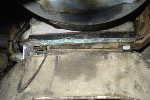rblais, I thought about what you said and actually went out and took a look at mine. I would agree with you that yes, if you placed the jack stand such that it was resting on the cold-forged hex-tube where the forward end of the torsion bar mounts in the control arm, that might not be so bad. I was assuming he meant more near the middle of the torsion bar behind the control arm. However, the torsion bar mount in the control arm was never designed to be a weight-bearing member. It was designed to apply a torsional force through the control arm to the wheel at that point. When you place the jack stand under it, you completely change the loading on that lower control arm. (The force at that point completely reverses direction when it rests on the stand)
Would it work? Sure, but again, why would you need to? The factory jacking point on the control arm is literally inches away, and there's no chance of it slipping off a standard jack stand as it actually hooks over the stand's saddle (at least it does on every stand I've used on them).
I understand your point about the yield strength of the material, and yes, you are right, it's not likely being exceeded, but againthat's not the point. There is a better, safer, recommended, and no more difficult way to lift it up without taking any chance of damaging any components. Why do anything else?
Exactly
Jacking by the pumpkin isn’t going to hurt anything.
If that were the case then I am sure every time those leaf springs exerted differentiating weight on the 'axle tubes,' it would bend them.
That’s the way the axle is designed, the 8.8 axles use C-Clips because the carrier bearings and the wheel bearings support the weight of the vehicle…
One saying jacking up by the pumpkin is going to hurt something seems kind of self-defeating.
Could you please explain what "differentiating weight" is? That's a new term for me and I'm not too sure what you mean.
I would have to disagree with you about the bearings and their designed loads. The carrier bearings do NOT support the weight of the vehicle. The carrier bearings support the load that the pinion and ring gear places on the carrier, as well as the axial load on the axle shafts when cornering. They locate the axles from side to side. The majority of the radial loads due to the weight of the vehicle are carried by the axle bearings near the ends of the axle, very close to the spring perches. The length of the axle shaft acts like a large lever-arm to reduce the amount of force borne by the carrier bearings.
Now, at rest, the majority of the weight of the vehicle goes from the wheel, through the axle shaft, through the bearing, and up through the axle tube. The weight on the differential carrier bearings is actually down, and very minimal. That would tend to bend the axle tubes this way \_/ (greatly exaggerated). Now, when you pick up the rear of the truck by jacking the pig, the ENTIRE load of the vehicle goes from the jack head, down the axle tubes over a significantly long lever-arm, and up through the spring perches, trying to bend them this way: /-\. The only weight on the axle bearings is the weight due to the dangling tires. The rear axle was never designed to carry the weight of the vehicle on the differential housing. Otherwise, why run a spring on each side? Mount a single transverse spring on the differential and call it good. (Can you imagine how heavy the beam would have to be to support a 4500 lb truck by a central point?
Again, just because you can doesn't mean you should.
For the record, I didn't say that jacking the pumpkin WOULD hurt anything, I implied that it's not the best way to do it, and there is a better way for a good reason. We've all done it.... doesn't make it right (a hundred thousand Lemmings can't be wrong, can they?)















